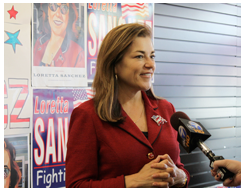Sea Breeze Pay-to-Play Shenanigans Shine Light on LA’s Corrupt City Hall
LA WATCHDOG--Pay-to-play is alive and well in Los Angeles as our Elected Elite continue to sell us out for cash campaign contributions, the ultimate aphrodisiac for Mayor Eric Garcetti and the members of the City Council.
In an excellent piece of investigative reporting, David Zahniser and Emily Alpert Reyes detailed how a sleazy real estate speculator / developer illegally funneled more than $600,000 through a network of questionable donors to selected members of the City Council and Mayor Garcetti. These contributions were part of a full court press to override the findings and recommendations of the City Planning Department and the City Planning Commission in the spring of 2014 that denied zoning changes and variances for Sea Breeze, a $72 million development of a 352 unit apartment building on land intended for industrial use in the Harbor Gateway area of the City.
[See A $72-million apartment project. Top politicians. Unlikely donors. Who wrote the checks to elected officials weighing approval? ]
But the $600,000 in campaign contributions was an excellent investment as the Planning and Land Use Management Committee of the City Council (“PLUM”), the City Council, and Mayor Garcetti approved the controversial zoning changes in early 2015, resulting in an estimated windfall profit well in excess of $10 million for the ethically challenged speculator.
Assisting with these zoning changes and variances benefited former Council Member Janice Hahn to the tune of $203,500 in campaign contributions. After she departed for Congress in late 2011, Joe Buscaino, the new Council Member for Harbor Gateway, “earned” $94,700 by ushering the developer’s appeal through the Planning and Land Use Management Committee. And as we all know, professional courtesy dictates that the local Council Member rules supreme in his district, no matter how bad the rotten Harbor fish stink.
The developer was not taking any chances as he also greased the palms of Jose Huizar, the Chair of PLUM, and the two other committee members, Mitch Englander and Gil Cedillo, with over $100,000 in contributions from a number of suspicious donors.
And that was topped off by multiple contributions totaling $60,000 to an independent campaign committee that supported Garcetti.
But this is well documented deal is not an isolated event as the pay-to-play game is taking place all over the City.
There is the NoHo West development in North Hollywood; the development the Martin Cadillac site on the congested Westside; the 27 story residential skyscraper in low rise Koreatown; the Cumulus monstrosity at the F rated intersection at La Cienega and Jefferson in South LA, the 1.6 million square foot Reef development in South Central, just south of DTLA; the Rocketdyne development in Warner Center section of Woodland Hills; and the Caruso luxury high rise apartment building near the already clogged intersections surrounding the Beverly Center.
And no doubt, other congestion causing monstrosities will be sprouting up all around town, especially in those parts of our City that are undergoing rapid gentrification like Boyle Heights, Echo Park, and Highland Park.
The corruption associated with the Sea Breeze development must be investigated by the City’s deliberately underfunded Ethics Department and Jackie Lacey, the County’s District Attorney, focusing not only on the sleazy developer and his partners in crime, but on all the beneficiaries of these illegal contributions.
At the same time, the City Council needs to adopt a rule that requires the real time disclosure of all campaign contributions (and behests) by any party affiliated with a council related action, including lobbyists and lawyers. This policy would also require our elected officials to sign off on these disclosures, with the requirement that they “know” their donors. This new rule has been labeled the “Political Donation Impact Review” by a neighbor to a mega-project that will cause ungodly amounts of congestion on surface streets and the adjoining freeway.
We also have the Neighborhood Integrity Initiative that has qualified for the March ballot. This reform measure calls for the City to plan for the City’s future, a task that has been neglected because it interferes with the fund raising activities of the City Council. The Initiative will require the City to update its General Plan and its 37 Community Plans. It will eliminate “spot zoning” where the City Council, under the leadership of the local Councilmember, will be able to create massive value for the developer by “up zoning” a specific property. It will also require the City to control the Environmental Impact Reviews, taking that responsibility away from the self-serving developers.
As an enforcement mechanism, the Initiative places a 24 month moratorium on “up zoned” projects. But contrary to the propaganda put out by its developer funded opponents, the Initiative does not place any restrictions on projects that are consistent with existing zoning regulations.
Reform of the City’s planning process has been made more complicated by the approval by the voters of JJJ, the Affordable Housing and Labor Standards Act, that requires inclusionary zoning and the equivalent of a project labor agreement on residential projects seeking zoning changes for projects of more than 10 units. However, with all the financial constraints imposed by JJJ and its numerous loopholes, the new law will lead to even greater corruption as it gives the City Council more power over residential developments.
In the next four months prior to the March election, we will have a raucous debate involving City Planning, the General Plan, the Community Plans, congestion, increased density, the allocation of the necessary resources to the Planning Department, and the absolute requirement for greater transparency into the impact of development on our local communities.
This process will also provide us with insight to the rigged system where real estate developers and the City Council are in cahoots with each other in ways that work against our best interests and those of our residential communities.
Sea Breeze is not an isolated deal. It is just the tip of the iceberg.
(Jack Humphreville writes LA Watchdog for CityWatch. He is the President of the DWP Advocacy Committee and is the Budget and DWP representative for the Greater Wilshire Neighborhood Council. He is a Neighborhood Council Budget Advocate. Jack is affiliated with Recycler Classifieds -- www.recycler.com. He can be reached at: lajack@gmail.com.)
-cw













 Sanchez, on the other hand, has developed a reputation over her twenty years in House of Representatives as a legislator who can work in a bipartisan manner, much like Senator Diane Feinstein who has been an effective proponent for California. She has the endorsement of 17 of the State’s Democratic Congressional representatives, almost double the number that are supporting Harris.
Sanchez, on the other hand, has developed a reputation over her twenty years in House of Representatives as a legislator who can work in a bipartisan manner, much like Senator Diane Feinstein who has been an effective proponent for California. She has the endorsement of 17 of the State’s Democratic Congressional representatives, almost double the number that are supporting Harris. 




 Notably lacking is any discussion about the economics associated with this ballot measure. But according to several sources, this initiative will increase construction costs by about 30% to 40%, in large part because of the onerous hiring requirements (see below) contained in the initiative.
Notably lacking is any discussion about the economics associated with this ballot measure. But according to several sources, this initiative will increase construction costs by about 30% to 40%, in large part because of the onerous hiring requirements (see below) contained in the initiative. 




 David Wright (left), the Interim General Manager, is a relatively new addition to the Department’s management ranks, but has had considerable utility experience, including as General Manager of Riverside Public Utilities. As the Chief Operating Officer, he also has an understanding of DWP, its management, its strengths and weaknesses, and its highly politicized environment.
David Wright (left), the Interim General Manager, is a relatively new addition to the Department’s management ranks, but has had considerable utility experience, including as General Manager of Riverside Public Utilities. As the Chief Operating Officer, he also has an understanding of DWP, its management, its strengths and weaknesses, and its highly politicized environment. 





















